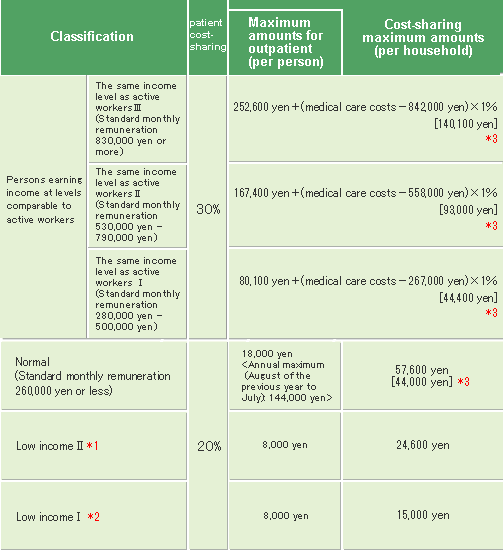 |
Elderly persons aged 70-74 pay 20% or 30% of medical costs, depending on their income
 |
 |
 |
 |
| |
 |
 |
Persons receiving income at the same level
as before retirement |
 |
 |
|
 |
 Cost-sharing maximum
amounts for the elderly Cost-sharing maximum
amounts for the elderly
|
 |
There are ceilings to elderly persons' monthly cost-sharing.
Elderly persons pay amounts up to these maximum amounts by presenting a medical care certificate for the elderly.(*)
Insurers reimburse persons aged 70-74 for the applicable balances
in the event they are living in the same household and covered under
the same medical care insurance even when outpatient and inpatient medical
care expenses borne within a period of one month surpass the cost-sharing
maximum amounts per household. |
Those using a Myna health insurance card need not pay more than the cost-sharing maximum amount at medical care institutions because their maximum amount information is provided with no need to give their consent, even without a Certificate of Application of Maximum Copayment Amount. However, those to whom á@ and áA below apply must submit a Request for Issuance of Certificate of Application of Maximum Copayment Amount to the Health Insurance Society in advance to avoid paying more than the cost-sharing maximum amount at medical care institutions.
á@Those falling in the category of the same income level as active workers Ⅰ or active workers Ⅱ who are unable to use a Myna health insurance card
áAThose falling in the Normal category who would like to be treated as being in the category of low income Ⅰ or low income Ⅱ because the insured person is exempt from taxation.
* Attach a certificate of exemption from resident tax. Contact the Health Insurance Society in advance, since the relevant tax year may vary depending on the month of the application.

| *1 |
Persons who are insured persons and dependents, and exempt from paying municipal tax. |
| *2 |
Persons above in households whose insured persons and dependents are all exempt from paying municipal tax and whose incomes meet certain standards. (e.g., annual pension income of no more than 800,000 yen) |
| |
*To be treated as being in the category of low income I or low income II, you must apply in advance for a health insurance maximum copayment/reduced standard copayment certificate even if using a Myna health insurance card.
|
| *3 |
Amount in brackets applies to all subsequent treatments that correspond to high-cost medical care expenses after the household has already borne such expenses three months within the nearest twelve-month period. |
* |
Half of the corresponding amount in the table above will be exceptionally applied, for a new insured person under Medical Care System for the Advanced Elderly, as the cost-sharing maximum amounts (per person) for the month in which he or she will turn 75 and become an insured person under the system (not including cases in which the insured person's 75th birthday will be the first day of that month).
(The cost-sharing maximum amounts under Medical Care System for the Advanced Elderly will also be half of the corresponding amount.)
The same measure will also be applied for the case when their dependents shift to be covered under the National Health Insurance or other plans. |
* |
If you fall into the category of the same income level as active workers, you will be treated as such, even if you are exempt from paying municipal tax. |
* |
Even persons earning income at levels comparable to active workers will be grouped in the Normal category if their annual income is less than a certain base amount (3.83 million yen for an elderly person living alone, 5.2 million yen for multiple elderly persons living in the same household) and their patient cost-sharing rate shown on their medical care certificates for the elderly is 20% due to a request for application of the base income amount. |
|
|
Annual High-Cost Medical Care Benefits for outpatient care (annual total of outpatient costs) for those aged 70 or older
Insured persons and dependents aged 70 or older whose total copayments for outpatient care during the one year period (from August 1 of the previous year to July 31) exceeded 144,000 yen are eligible to be reimbursed for the excess amount as High-Cost Medical Care Benefits.
See here for more information: "When your medical care costs grow large" |
Payment of high aggregate cost for long-term care service
To reduce high co-payments, a system will be established whereby the co-payments for health insurance and long-term care insurance are aggregated annually and benefits paid to cover high aggregate cost for long-term care service if this annual aggregate is remarkably high.
See here for more information: In cases in which the co-payment for medical care or long-term care is remarkably high.
|
|
 |
|
 |
